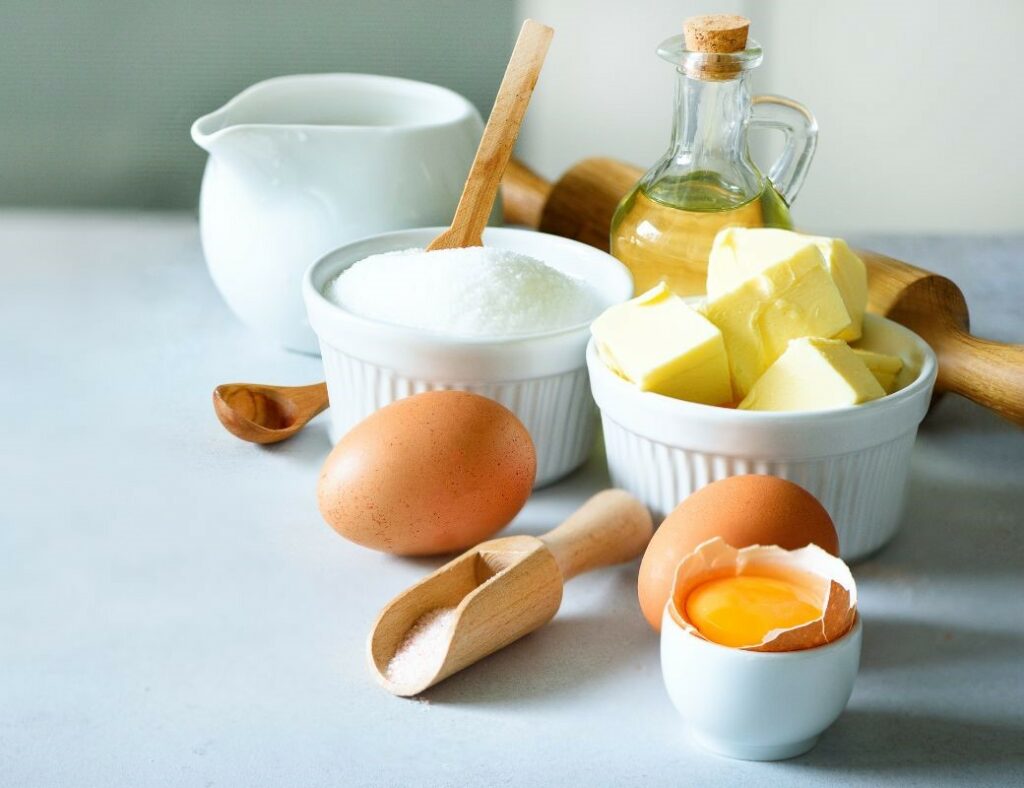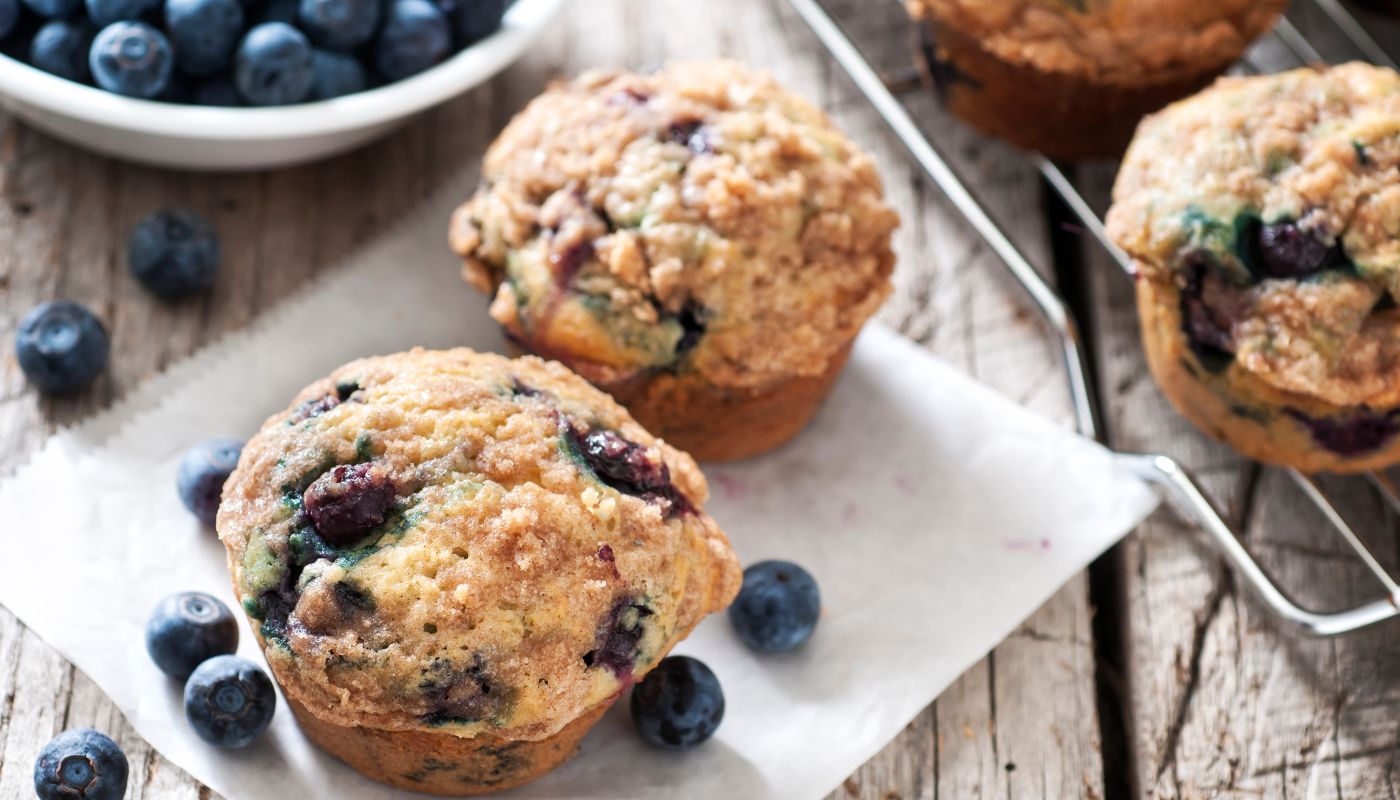Whether you’re an avid baker or just someone who enjoys the occasional Saturday morning pancake, it’s natural to wonder how baking fits into your gestational diabetes management plan. The good news is that you don’t have to give up baking entirely, even if you’re on a blood sugar management journey. In fact, with a few mindful tips and strategies, you can continue to enjoy your favorite baked goods while managing your blood sugar levels and supporting your overall health.
Read on for my top tips for blood sugar friendly baking.
Table of Contents
Pairing Baked Goods with Protein, Fat, and Fiber
One of the key principles of intuitive eating (an eating framework I follow and recommend as a registered dietitian and intuitive eating counselor, read more here) is to honor your hunger and fullness cues. When it comes to blood sugar friendly baking, one of the best ways to support our blood sugars is going to be considering what we can add. This means thinking beyond the muffin or cookie itself. For example, instead of eating a solo muffin for breakfast, try pairing it with a source of protein, such as eggs, or include it as part of a balanced meal.
The idea here is to create a satisfying and balanced meal that includes a variety of foods. Pay attention to your body and notice how much you need to feel full and satisfied. By combining baked goods with protein, healthy fats, and fiber-rich foods, you can help stabilize your blood sugar levels and keep those intense cravings in check.
We like to call this gentle nutrition in the intuitive eating space. It’s asking yourself what you desire or crave and what your body needs to thrive. Learn more about gentle nutrition here.
Experiment with Recipes for Blood Sugar Friendly Baking
Next, if you’re baking for gestational diabetes, I want you to consider how we can experiment with the baked goods themselves. If you’re interested in blood sugar friendly baking and want to take a more proactive approach to managing your gestational diabetes, experimenting with recipes to see what works for your body can be a fun and creative way to go about it. You don’t necessarily have to overhaul your favorite recipes; instead, focus on making small adjustments to increase the protein, healthy fats, and fiber content while lowering carbohydrates.
A few examples to get you started:
- Try using almond flour or coconut flour to replace some of the regular flour in recipes. These alternative flours are lower in carbohydrates and higher in fiber, which can help slow down the absorption of sugar into your bloodstream.
- Add things like chia, hemp or flax seeds. This adds fiber, they are rich in omega-3 fatty acids, and are also a good source of plant based protein.
- Add eggs! This may seem a little odd, but sometimes you can add an egg or two to recipes without noticing it. This adds some extra protein and choline, which is great for pregnancy.
Consider Baking Substitutions and Ingredients

If you’re interested in exploring baking substitutions and ingredients that align with your gestational diabetes management plan, there are several options available. While I’m not a fan of strict diets like keto or paleo, you might find some helpful baking substitutions and ingredients within these approaches when you’re baking for gestational diabetes.
Flours:
In most recipes you can substitute almond for all purpose flour to reduce the amount of carbs and increase the protein in the recipe. Some other recipes may call for the addition of coconut flour, another low-carb option, as it tends to be more absorbent than almond flour. Experimenting with these flours on their own or using a combination of them in recipes is a great alternative towards preventing blood sugar spikes. Ultimately when using a substitute to all-purpose flour, you are looking to achieve the correct ratio in terms of consistency and texture.
For example, a general rule of thumb for almond flour is that it can be used as a 1:1 conversion for all purpose flour. However, you may find that you need to add a little more almond flour due to its higher moisture content. Be open to seeing what substitutions and additions work best for you and your favorite recipes!
- King Arthur Keto Wheat Flour: You can swap this flour 1:1 (by volume or weight) for traditional all-purpose flour, making it a simple swap in your favorite recipes!
- King Arthur Almond Flour: per their recommendations, “Unlike Keto Wheat Flour, you can’t simply swap almond flour in for all-purpose and call it a day… Without gluten, almond flour lends a delicate, tender texture to baked goods, as well as a rich, buttery flavor. Try a recipe like Almond Flour Pizza Crust to get a low-carb taste.”
- Bob’s Red Mill Paleo Flour: A blend of almond flour, arrowroot starch, coconut flour and tapioca flour and a great lower carb option! I’ve never used this flour before but it’s advertised as a great option for muffins, cookies, pizza, and more!
- Simple Mills: This brand does not offer a “keto” or low carb alternative that I have seen, and most of their baking mixes come in at about 10-15 grams of carbs per servings, so while it may not be the “best” or easiest mix to use, it could be a reasonable option for you (you might just have to look at the item you’re making as a whole, for example, you may want to skip the frosting if you use this mix!)
- Kodiak Cakes: They have a waffle and pancake mix that’s higher in protein and fiber, making it a great starting point for your baking experiments! Follow the instructions as listed on the box.
- Birch Benders: This brand also has “keto carb-friendly” pancake and waffle mixes that might be worth a try!
Sugar and Natural Sweeteners
There are many different substitutes for sugar on the market today, so it can be confusing when looking for a blood sugar friendly option to replace regular sugar in your baked goods. The sugar substitutes listed below are all low-glycemic sweetener alternatives, meaning they won’t directly raise your blood sugar. When used for baking many of these sweeteners will react differently than table sugar. Oftentimes in baking, sugar helps provide structure to the item, in addition to sweetness, so your end product will likely have a slightly different texture or density. That means that it may take a little experimentation to get things “just right”!
Also note: if you are using a liquid product, that typically only requires a few drops to add sweetness. When in doubt, read the package directions for how to best substitute the product in your baking.
Read on for more tips on these sweeteners.
- Monk fruit sweetener: typically has little to no effect on blood sugars. You can replace 1:1 in any of your favorite baking recipes to lower the carbohydrate and sugar content.
- Stevia: does not offer the same texture as sugar when used in recipes and is much sweeter than refined sugar, so a little can go a long way in your baked goods.
- Sucralose (a.k.a. Splenda): Heat stable for baking; you can also replace half the sugar with Splenda or buy a blend of the two. Splenda also makes a brown sugar blend with 50% brown sugar, 50% sucralose.
- Erythritol: contains about 70% of the sweetness of sugar and contains zero carbs. A few erythritol-based brown sugar brands to try: Purecane’s Brown Sweetener, Swerve, or Truvia. This should be used in smaller quantities, as it tends to crystalize when baking
A note about these other common sweeteners, because I get asked about them alot. People often see them as “natural” sweeteners and think they must be better for blood sugar, right? I’m sorry to break it to you but dates, honey and maple syrup are still sugar and will raise your blood sugar. If you prefer the taste or they are more convenient for you, by all means use them! (I do live in Vermont where we have lots of honey and maple syrup so I’m no stranger to these tasty options)
- Date sugar: (derived from dates) has no added sugar and could be a good option to try! Date sugar does have natural sugars and carbs (since it comes from a fruit) but it also has fiber, which can help stabilize blood sugars! Use date sugar 1:1 for white or brown sugar.
- Honey is 25 to 50% sweeter than sugar, and has a distinctive flavor. Baked goods made with honey are typically moist, dense, brown faster than baked goods made with granulated sugar.
- Maple Syrup: Maple syrup is only 60% as sweet as sugar, but it’s typically recommended to use ¾ cup for every cup of white sugar. Also, when using maple syrup try to decrease the amount of liquid by 3 tablespoons since maple syrup is also a liquid.
- Fruits: As an alternative, working with whole fruits (like berries or bananas) allows for you to enjoy the natural sweetness of these fruits with the added benefit of fiber in your diet, proving to be another great option in your recipes.
These flours, mixes, and sugar substitutions can be a great way to practice gentle nutrition. Remember, we aren’t using them because regular flour is “bad”. We’re using them because you have unique needs and these can help you honor them!
Reflect on Your Reasons for Eating
Taking a moment to reflect on why you’re choosing to eat certain foods can also be incredibly enlightening and supportive of your baking for gestational diabetes journey. Remember, the key here is mindfulness. Ask yourself: what can I add to this baked good for blood sugar support? Am I turning to this food because I’m feeling restricted or rebellious due to dietary restrictions? Am I enjoying this food as part of a cultural practice or a special celebration, like a birthday?
Understanding your motivations for eating certain foods can help you make more intentional choices. There is no “wrong” reason to eat these foods, but if you find yourself overeating them or turning to them to deal with emotions, it may be worth getting some support from an intuitive eating dietitian.
Baked goods are often a part of celebrations, or can be important to certain cultural events. And sometimes, they are just a fun addition to your day. This is why I want you to be able to enjoy them, without the side of guilt. The key is to check in with your needs and balance these “fun foods” with nutritious options that support your overall health and well-being. Learn more about mindful eating and dealing with emotions outside of food here.
Embrace Imperfection and Nurture Your Relationship with Food
During pregnancy, especially when managing gestational diabetes, it’s crucial to focus on nurturing a healthy and positive relationship with food. Your body is changing rapidly, and pairing that with new food rules and guidelines, it can become hard to maintain a healthy and neutral view of food and your body. While we want to make mindful choices, know that perfection isn’t the goal. It’s okay to enjoy food without a side of guilt. If you find yourself struggling to do so, I encourage you to reach out to a dietitian who specializes in intuitive eating. Learn more about my coaching here.
In conclusion, managing gestational diabetes doesn’t mean you have to bid farewell to baking or delicious treats. By embracing intuitive eating principles, making thoughtful recipe adjustments, reflecting on your eating habits, nurturing a positive relationship with food, and considering baking substitutions, you can continue to enjoy the pleasures of baking while prioritizing your health and the health of your growing baby. Remember, it’s all about balance, not perfection, and finding what works best for you during this special time. Happy baking!




 Hi! I’m Emily.
Hi! I’m Emily.

0 Comments